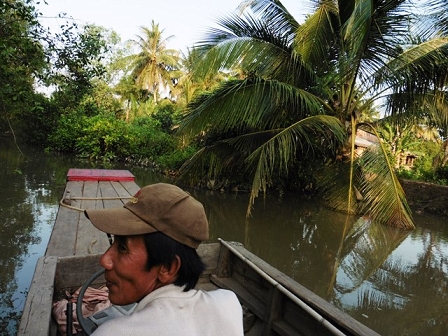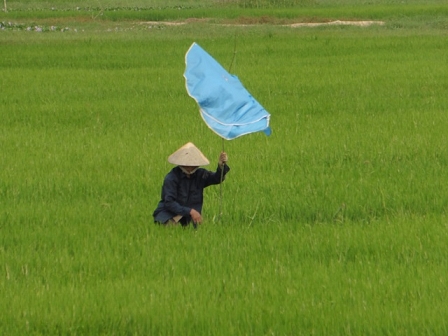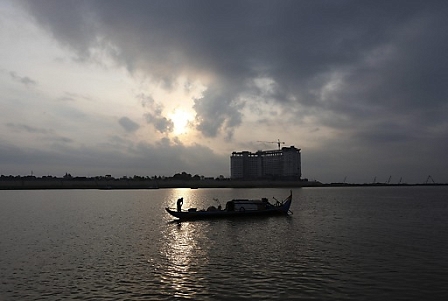Erstellt am: 28. 4. 2015 - 11:02 Uhr
A Slow Death for the 9 Headed Dragon?
You see can see some of the legendary bounty of the Mekong Delta at the bustling town Ben Tre. Barges ply the café-latte coloured waters, chugging under a concrete bridge from which young boys fly colourful kites.
On Saturday 2 May, 12:00, Fm4 RC takes an in depth look at life in Vietnam, 40 years after reunification.
The barges are heavily loaded with agricultural goods; mangos, pineapples, coconuts, potatoes and sacks of rice in burlap sacks.

Chris Cummins
Some of the barges are so low in the water that you fear that a medium-sized wave might engulf them completely. It seems like an apt metaphor for the whole region.
"The richness of the Mekong is intrinsically linked to the fragility of the system,” warns Marc Goichot, a Mekong expert at the WWF, “It is a very rich ecosystem for biodiversity and for man. But it is a very fragile one."
Nine Dragons
The Vietnamese call the Mekong Delta the Cuu Long, or Nine Dragons, because, as it nears the end of its 4,000 km journey, the Mekong splits into nine main channels as it heads to the sea. Irrigation ditches and canals spider out from the natural channels that criss-cross the flood plains; thousands of veins spreading out from the main natural arteries. Many levees were built by Ngyuen lords in the 16th century but in the past 50 years the engineering works have intensified dramatically.

Chris Cummins
When the autumn floods come these channels dump sediment from upriver over the fields, granules of nutrients from as far away as the river’s source in Tibet and whole chunks of alluvium from Laos and Cambodia. This gives the water rich orangey-brown colour and it’s also what makes the land so fertile
"The area feeds around 40 million Vietnamese and provides a sizeable chunk of the country’s export revenue," says Bill Hayton, author of Vietnam: Rising Dragon, a social and political study of modern day Vietnam.
You can see the bounty by cycling along the gravel paths that skirt along the banks of the many channels that spread of the town. There are coconut fronds, mango trees and tall leafy trees laden with scarlet Vietnamese plums. Regular hump-backed bridges traverse the narrower waterways and you can hitch a ride of one of the many ferries that cross the wider channels.
As we pass small plantations of papaya, jackfruit my southern Vietnamese guide, Phuong, or Lucy as she likes to be called, throws her arms left and right, pointing at the fruit and shrieking each time: "Very delicious!" There are also fields of flowers and decorative bonsai trees to brighten the homes of the people of nearby Ho Chi Minh City. Not far away you'll glimpse the emerald rectangles of the flooded paddies.
Incredible Bounty of Fish
On the banks you’ll see fishing nets and spidery traps fashioned out of bamboo. "There’s 360 species of fish in the Mekong Delta alone," says Marc Goichot, "Many of them are visitors that come from the sea or visitors that have come from upstream and use the Delta as part of their reproductive cycle."
Some of the edible fish, as well as pyramids of exotic fruits and dozens of varieties of rice, are on display in the vibrant markets at Can Tho; both the floating market that draws the tourists and the hot, malodorous one that is held on the banks, along narrow dark alleys. There, under the shade of tarpaulin, you’ll find every sort of food you imagined or perhaps even didn’t dare imagine.

Chris Cummins
In the West we hide the brutal reality of the food industry behind closed doors, but the Vietnamese have no such scruples and, with their obsession with freshness, market women decapitate live frogs and slicing the fins off live fish in from of your eyes.
Brutal Honesty
There are blue buckets filled with yellow squirming chicks and grown hens tethered together by the ankle and shoved into small cages.
There are also tables laid out with the carcasses of recently gutted mice and more live mice in cages. "We don’t waste anything edible in Vietnam," says Lucy, smiling at my slightly nauseated curiosity, "Maybe because we are a poor country and until recently we couldn’t afford to waste anything."
Nature in a straightjacket
The memory of food shortages drove the taming of the Mekong Delta. For centuries just one harvest was possible each year on this natural flood plain, as farmers waited for the waters to subside enough for a short planting season.
But through dykes and barriers the flooding has been controlled, prolonging the season and enabling first two and now three harvests. Although ingenuous, this engineering has come at a cost. A complex system of regeneration through flooding has been interrupted while agricultural chemicals have degraded the water and acidified the soil.

Chris Cummins
Now scientists warn the system is at breaking point and unless its cry for help is heard, the result could be a biological collapse triggering an economic and social crisis.
"You’d have an awful lot of farmers and traders that wouldn’t be able to earn a living anymore," says Bill Hayton, "There’d be pressure on them to leave the land or move to the cities. A way of life would be destroyed."
Scientists say the river needs space to breathe and regenerate. And yet, in its biologically weakened state, the Mekong Delta faces the immense threat of climate change. Global warming means melting ice caps and scientists predict a mere 1metre rise in sea levels could engulf 40% of the delta.
Rising Sea Levels
Already the effects are being felt. For 6,000 years, explain Goichot, the Mekong Delta, fed by the sediment from upstream, was growing in size every year. But now the patterns have been reversed.
"There’s a net loss of about 4m per year. That translates as losing the equivalent of a football field every year to the sea."
Yet the barriers that should give at least some protection against the sea have been chopped down to make more room for farmland. Already tides are bringing salt-water further upstream, turning the emerald green of coastal paddies a sickly brown.

Chris Cummins
But, paradoxically, the most pressing immediate threat is a technology that has been sold as a mitigation tool against the severity of climate change - the series hydroelectric projects upstream on the Mekong river system. "The Delta is at the end of a very large and very charismatic river," says the WWF’s Marc Goichot. "It is the place where all the changes in the basin are felt and measured."
Hydroelectric projects built in China and more recently started downstream in Laos have interrupted the flow of that sediment that sustains the system. Goichot says that 25 years ago the Mekong was producing 160 million tons of sediment a year. Then in 1993, the first dam on the Mekong main stem was built in Manwan, China; the beginning of the dam building boom. Now it is estimated that the river produces about 70 million tons of sediment a year - a 50% reduction that can't go unnoticed.

EPA/MAK REMISSA
The sediment fertilises the fields but, lining the bottom of the river, it also provides breeding ground for many of the fish species that provide the catches for the fishermen and a large proportion of the animal protein of the population, both in the Delta and upstream in Laos and Cambodia.
In a 2010 report the Mekong River Commission is the intergovernmental agency among Thailand, Laos, Cambodia and Vietnam, has estimated the projects currently planned could cause a loss of 26 to 42 percent of fish in the river system. It recommended a 10 year moratorium of further dam building but it is an advisory board with no real political teeth.
What happens upstream effects Vietnam greatly, but there is very little Vietnam can do to influence these changes.

Chris Cummins
Other Options?
Hydroelectric power brings money to government coffers and poverty-stricken Laos has stated its aim to be a "green battery" for South-East Asia.
Given the dual challenges of climate change and poverty, cashing in on renewable energy might seem like a reasonable policy.
Dieses Element ist nicht mehr verfügbar
But Dr Ian Baird, a Mekong expert at the University of Wisconsin, who lived for 15 years on an island on the great river in Laos, says that if the region is looking for green energy, it is looking in the wrong place: "Certainly South-East Asia has a huge amount of sunlight. The cost of solar has dramatically decreased in the last couple of years. We may see hydropower becoming relatively uneconomical in relation to solar within a very short period of time."
By that time, however, if all the hydroelectric projects are completed, the damage will have been done to large parts of the Mekong Delta.


